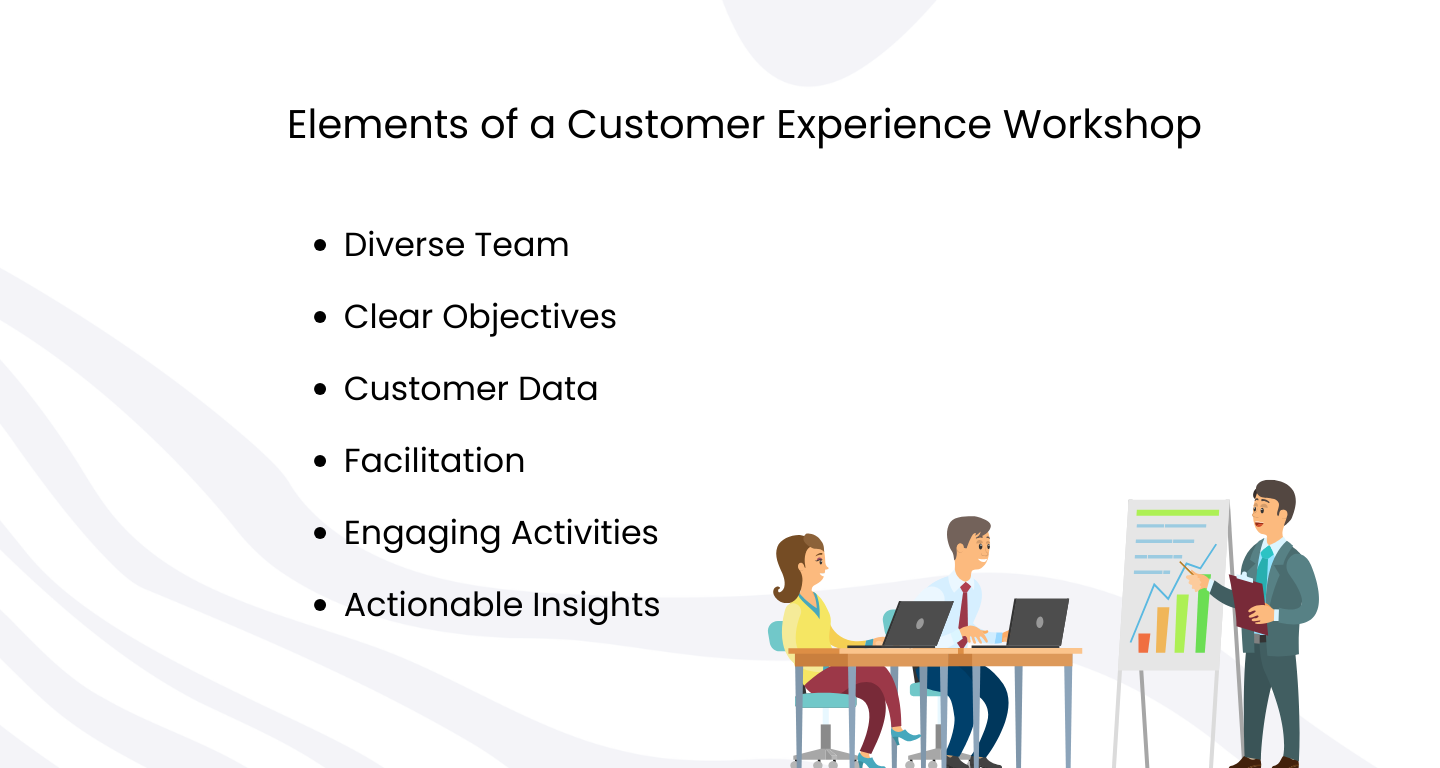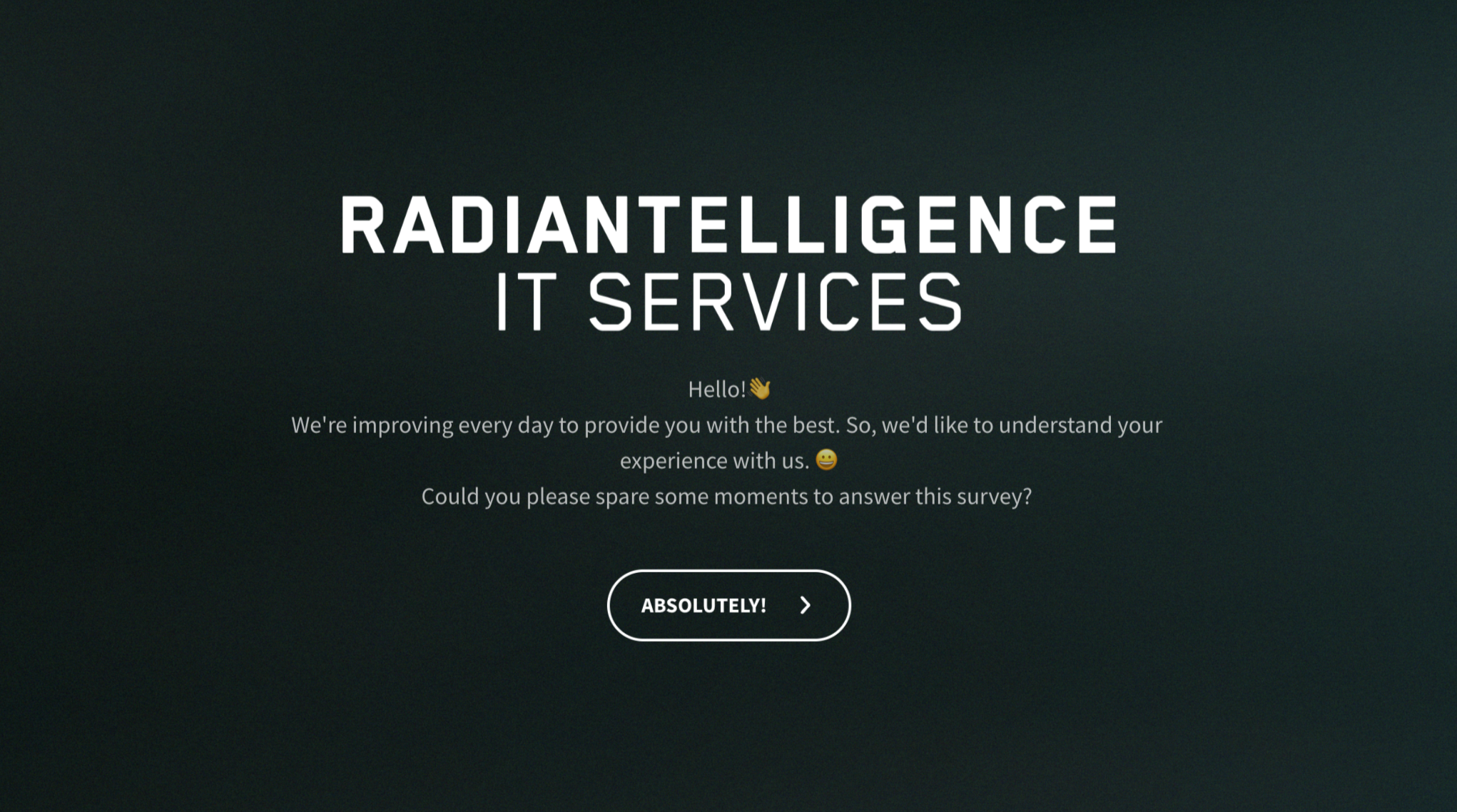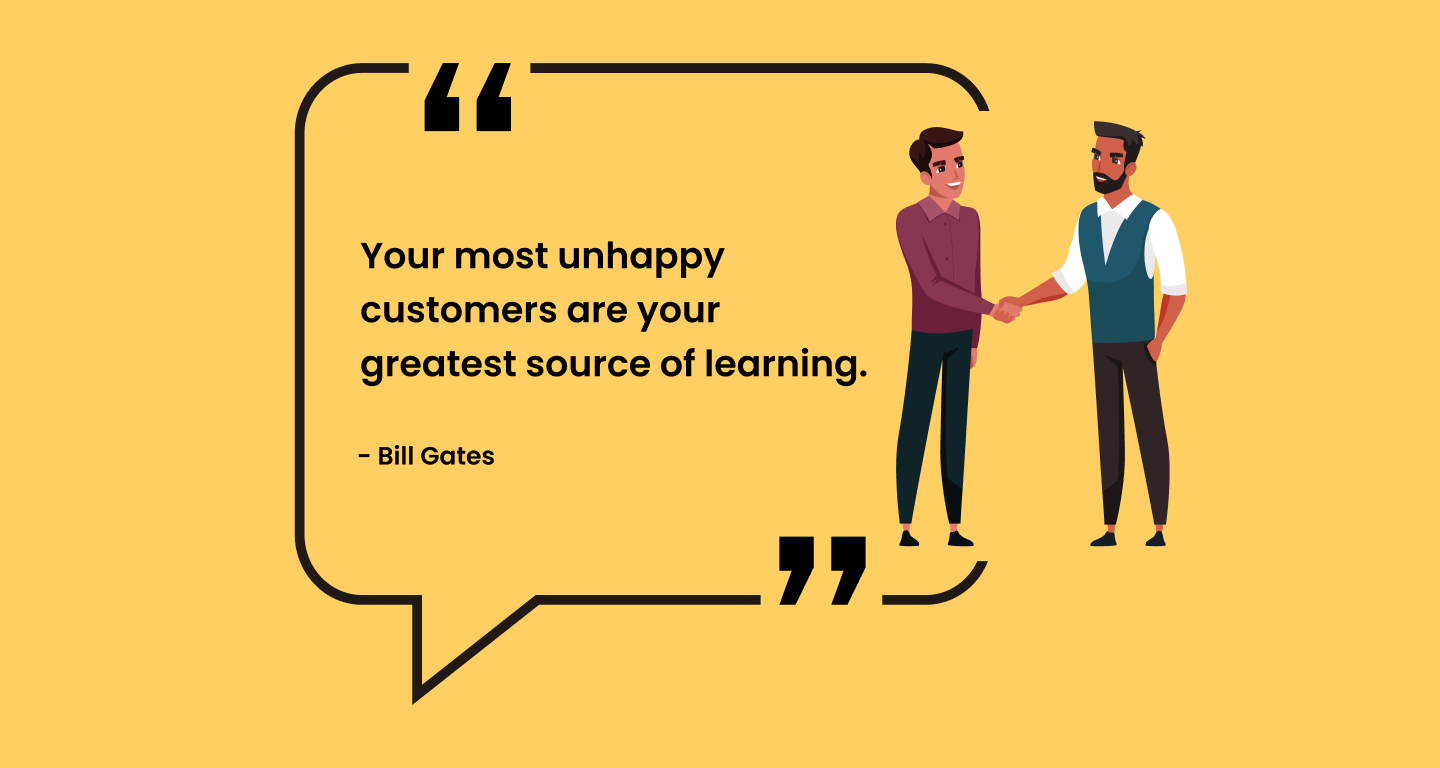Customer Experience
Your Ultimate Guide to Customer Experience Workshops
Article written by Kate Williams
Content Marketer at SurveySparrow
11 min read
19 September 2025

60 Seconds Summary:
Customer experience is a key differentiator that can set your business apart considering the competitive market we have today. One effective way to enhance how customers perceive and interact with your brand is through a focused customer experience workshop. This type of collaborative session brings together diverse teams to explore, innovate, and align strategies to create memorable and satisfying customer journeys.
Let's explore what a customer experience workshop involves, why it matters, and how you can run one to find new opportunities for customer satisfaction and business growth.
Did you know that 61% of consumers are willing to pay a premium of at least 5% for a promise of exceptional customer experience? That’s huge! So, how do some businesses stand out in the crowd? Well, the secret lies in their commitment to improve and enhance customer experience. And one powerful tool that can help achieve this is a customer experience workshop. But what exactly is a customer experience workshop, and why is it so important? Let’s see.
What is a Customer Experience Workshop?
A customer experience workshop is a dedicated space and time where a group of people from different parts of a company come together to make their customers happier. It’s like a creative brainstorming session, but with a specific focus: improving the way customers feel when they interact with a business.
Take a company with many departments like sales, customer service, marketing, and product development. Each department has its role in making customers happy, but sometimes they don’t work together as well as they could. A customer experience workshop is like a meeting where these different departments gather to talk about how they can work together better to create a great experience for customers. It’s like fine-tuning the gears in a machine to make sure everything runs smoothly.
The magic happens when these teams put their heads together and figure out how to combine their ideas to create an amazing experience for customers. So, in short, a customer experience workshop is like a super-planning session where different experts from a company gather to make sure customers have a fantastic time when they interact with that company.
If you're just beginning your CX journey or want to deepen your understanding, check out this detailed guide on customer experience management to lay the foundation.
Read More: 10 Best Customer Experience Books of All Time
Why is a Customer Experience Workshop Important?
Let’s admit it, success hinges on customer satisfaction. This is where a CX workshop emerges as a crucial cornerstone. At its core, it is a structured and collaborative session. It unites teams from different departments within a company to focus on a single, paramount objective: enhancing the overall customer journey.
A customer experience workshop is basically like a friendly gathering where these team members sit down to solve a CX puzzle. They discuss how to fit them together seamlessly to create a picture that makes customers smile. It’s like everyone sharing their ideas on how to make the puzzle look amazing.
1. Enhanced Customer Loyalty
Think of loyal customers as your biggest fans. They not only attend every show but also bring their friends along. By investing in customer experience, you’re investing in these loyal fans. A well-crafted workshop helps you understand what makes them cheer, and you can replicate those moments to keep them coming back for more..
2. Competitive Edge
Every business is competing for attention. A well-executed workshop helps you identify unique strategies and customer touchpoints that differentiate your brand from the competition. When your customers see something special, they’re more likely to choose your performance over others. Learn how to manage this end-to-end using CX software tools like SurveySparrow.
3. Innovation Catalyst
These workshops encourage creative thinking. They spark innovation within your team. It’s where creative ideas take center stage. By encouraging your team to think outside the box, these workshops become the birthplace of groundbreaking strategies and solutions.
4. Data-Driven Decision Making
You know what the best part is? Workshops act like data collection hubs. They gather insights and feedback from different corners of your business, transforming them into actionable strategies and improvements. It’s like turning critic reviews into constructive feedback for your next performance.
The Elements of a Customer Experience Workshop
What is required to run an effective CX workshop? What we need to understand is that it's not just a gathering. Workshops are well-structured events designed to fine-tune a journey. Running a customer experience workshop involves gathering the right resources and people to create a fulfilling and insightful journey. Here are the key elements that make up a CX workshop:

1. Diverse Team
A successful workshop begins with a diverse team. This team should represent different aspects of your business, including marketing, sales, customer support, and product development. Each perspective adds a unique layer to the discussion, resulting in comprehensive solutions.
2. Clear Objectives
Define the precise goals of your workshop. Clarity is key. A workshop should have well-defined objectives. What specific aspects of the customer experience are you aiming to improve? Having a clear goal ensures everyone is on the same page.
3. Customer Data
Analyzing customer feedback, surveys, and historical data provides valuable insights into pain points and areas for improvement along the customer journey. Start with a ready-to-use user experience survey template to gather fast insights.
4. Facilitation
The right facilitator can be the difference between an average workshop and an exceptional one. They keep the journey on track, ensure everyone’s voice is heard, and navigate smoothly through discussions. An experienced facilitator can make a world of difference in the workshop’s effectiveness.
5. Engaging Activities
Boring workshops yield dull outcomes. Incorporate interactive exercises, brainstorming sessions, and role-playing to keep the energy high and the creativity flowing. They break the journey into memorable moments.
6. Actionable Insights
A successful workshop concludes with a list of actionable insights. These are actionable insights and a roadmap for implementing changes and improvements based on workshop discussions.
How to Run a Customer Experience Workshop
Running a customer experience workshop isn’t a one-and-done event; it’s an ongoing journey of improvement. Just like a chef perfects their craft with each dish, your customer experience strategies should evolve and adapt based on the insights gained through workshops.
#1 Preparation
- Set Clear Goals: Like plotting a course, define what you want to achieve in the workshop. Be specific about which aspects of the customer experience need improvement. This ensures everyone knows the workshop’s purpose.
- Gather Materials: Collect necessary resources such as customer feedback, relevant reports, and any software or tools needed for analysis. These are like the ingredients you need for your workshop.
- Location and Logistics: Choose a comfortable venue with suitable facilities. Ensure technical equipment, seating, and even snacks, if required, are well-organized.
#2 Engagement
- Interactive Activities: Keep participants engaged with hands-on activities, brainstorming, and group discussions. Encourage active participation to make the workshop lively.
- Use Varied Presentation: Prevent boredom by mixing things up. Combine presentations, visuals, and practical exercises. People have different learning styles, so offering variety keeps everyone interested.
- Clear Communication: Start with a straightforward explanation of the workshop’s objectives and agenda. Regularly recap important points to ensure everyone stays on track and understands the goals.
#3 Feedback Collection
- Feedback Forms: Gather opinions from participants at the end of the workshop. These forms can contain questions about the workshop’s content, organization, and how effective it was.
- Encourage Live Feedback: During the workshop, encourage real-time feedback. Use techniques like live polls or group discussions to capture immediate thoughts and suggestions.
Plus, Pre-designed Survey templates make everything so much easier.

#4 Action Plan
- Analyze Insights: After the workshop, dive into the insights and ideas generated. Identify common themes and prioritize key findings based on their potential impact. This is where you decide which recipes to include in your action plan.
- Assign Responsibilities: Delegate tasks to team members for implementing the workshop’s outcomes. Clearly define roles and set deadlines to ensure accountability. It’s like assigning different chefs to various aspects of the meal.
- Create a Detailed Plan: Develop a roadmap that outlines the steps to be taken based on the workshop’s insights. Include timelines and milestones for each action, just like a recipe with clear instructions.
#5 Follow-Up and Implementation
- Stay in Touch: Schedule follow-up meetings to check progress and address any challenges. These meetings help ensure your action plan stays on track, like checking the cooking progress of a dish.
- Continuously Improve: Keep gathering customer feedback and data to assess the impact of changes made based on the workshop. Use this information to refine strategies and initiatives, much like refining a recipe.
- Celebrate Achievements: Don’t forget to acknowledge your team’s efforts and milestones along the way. Recognize the positive impact on the customer experience, just as a chef appreciates compliments for a well-cooked meal.
By the way, if you’re looking to streamline the process, there are many advanced platforms available in the market. Take SurveySparrow for example. You can create surveys, collate feedback, analyze, and act upon the rich insights you gain.
Sign up and see for yourself today! It’s free to try.
14-day free trial • Cancel Anytime • No Credit Card Required • No Strings Attached
Customer Experience Workshop Ideas
1. Customer Journey Mapping
Invite participants to walk in the shoes of your customers. Have them create detailed maps of the entire customer journey, highlighting pain points and opportunities for improvement. This helps visualize the customer’s experience.
2. Role-Playing Scenarios
Encourage team members to act out different customer scenarios. This interactive exercise helps them better understand customer emotions and challenges, leading to empathy-driven solutions.
3. Storytelling Sessions
Share real customer stories, both positive and negative. Discuss how these stories reflect the customer experience and brainstorm ways to replicate the positive ones and prevent the negative ones.
4. Design Thinking Workshops
Implement design thinking techniques, such as empathy interviews and ideation sessions, to foster innovative solutions. Design thinking encourages a human-centric approach to problem-solving.
5. Customer Feedback Analysis
Dive deep into customer feedback data. Analyze surveys, reviews, and comments to uncover valuable insights. This exercise can reveal recurring themes and pain points.
6. Personas Creation
Develop customer personas representing different segments of your audience. This exercise helps personalize the customer experience and tailor strategies to specific customer groups.
7. Service Blueprinting
Create detailed blueprints of your customer service processes. Highlight touchpoints, support channels, and employee interactions. Identify areas where improvements can enhance the customer journey.
8. Customer Empathy Workshops
Use exercises like “Empathy Circles” to build empathy among team members. This helps them understand the emotional aspects of the customer experience.
9. Brainstorming Sessions
Conduct structured brainstorming sessions to generate innovative ideas for improving the customer experience. Encourage participants to think outside the box.
10. Customer Persona Day
Dedicate a workshop day to immerse participants in the lives of customer personas. From using your products/services to facing their challenges, this hands-on experience fosters empathy and insights.
11. Cross-Functional Collaboration
Arrange workshops that bring together employees from different departments to discuss and solve customer-related challenges. Collaboration often leads to holistic solutions.
12. CX Gamification
Gamify the workshop by creating CX-related games or challenges. This not only makes learning enjoyable but also reinforces key concepts.
13. Customer Experience Awards
Host an awards ceremony where teams or individuals are recognized for outstanding contributions to improving the customer experience. This fosters healthy competition and motivation.
14. Customer Feedback Workshops
Bring in actual customer feedback (positive and negative) and work as a team to address each piece of feedback. This hands-on approach ensures that real customer voices drive improvements.
15. Customer-Centric Ideation
Encourage participants to brainstorm ideas for products, services, or features with a customer-centric focus. This can lead to innovations that resonate with your target audience.
Conclusion
A well-executed customer experience workshop can be a transformative experience for your business. It not only improves customer satisfaction but also fosters innovation and strengthens your competitive edge.
If you’re ready to take your customer experience to the next level, consider hosting a CX workshop. Remember, it’s not just about satisfying your customers; it’s about delighting them.
Ready to enhance your customer experience? Sign up for SurveySparrow today!
14-day free trial • Cancel Anytime • No Credit Card Required • No Strings Attached

Make your customers feel heard. Turn feedback into loyalty with SurveySparrow's CX platform.
Kate Williams
Frequently Asked Questions (FAQs)
It’s a group session where team members come together to talk about how customers feel when they use your products or services. The goal is to find ways to make those experiences better.
A workshop helps your team see things from the customer’s point of view. It can lead to new ideas that make customers happier and more likely to stay loyal to your brand.
People from different parts of your company—like sales, support, marketing, and product—should join. This way, you get lots of different ideas and viewpoints.
You might map out the customer journey, share real customer stories, brainstorm problems and solutions, and plan simple actions to improve customer experience.
Set a clear goal, invite the right people, and gather some customer feedback or reviews to discuss. Make sure you have a space (in-person or online) where everyone can join in.
After the workshop, you can check if customers are happier (using feedback or surveys) and see if your team is following through on the new ideas.
Related Articles

Customer Experience
10 Inspiring Customer Experience Quotes to Drive Business Success
8 MINUTES
21 June 2023

Customer Experience
Top 9 Customer Experience Trends for 2024 and 2025
9 MINUTES
24 July 2023

Customer Experience
B2B Customer Experience Journey: Stages, Examples & CX Strategies
13 MINUTES
4 July 2023

Customer Experience
High Touch Customer Service: A Guide to Exceptional Customer Experiences
13 MINUTES
1 October 2023
